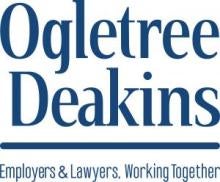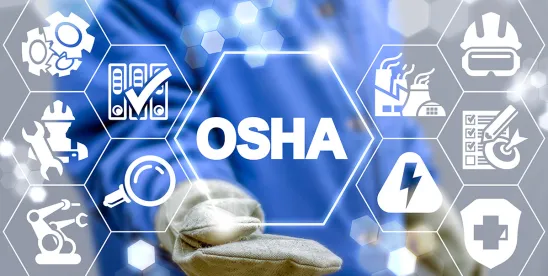On July 1, 2025, the Occupational Safety and Health Administration (OSHA) issued notices of proposed rulemaking (NPRM) related to twenty-six current standards. While some of the NPRMs will impact very narrow categories of employers, such as the NPRM seeking to clarify and narrow the application of the General Duty Clause, 29 U.S.C. § 654(a)(1), as it pertains to inherently risky activities that are integral to certain professional and performance-based occupations, many would have an impact on much broader cross-sections of occupations and employers. This article provides a high-level summary of six changes that will impact a number of employers.
Quick Hits
- On July 1, 2025, OSHA issued NPRMs affecting twenty-six current standards, with some impacting narrow categories of employers and others affecting broader cross-sections.
- OSHA proposes the removal of the requirement that people using N95, P100, and similar filtering facepiece respirators and powered air-purifying respirators (PAPRs) be subject to medical clearance before use.
- The DOL proposes to rescind outdated regulations for coordinating enforcement activities among agencies regarding migrant farmworkers, aiming to improve efficiency and modernize practices.
- Comments on the NPRMs are due by September 2, 2025.
OSHA’s Withdrawal of Proposed MSD Column on OSHA 300 Log
OSHA has formally withdrawn its proposal to add a musculoskeletal disorder (MSD) column to the OSHA 300 Log. This decision:
- leaves all employer obligations for injury and illness recordkeeping unchanged;
- does not alter the criteria or definitions for recording injuries and illnesses;
- is based on findings that an MSD column would not significantly improve national injury statistics, enforcement, or establishment-level data;
- concludes that existing data collection methods are sufficient and that the proposed column would not provide meaningful additional information; and
- imposes no new requirements or costs on employers.
Proposed Amendments to Medical Evaluation Requirements in Respiratory Protection Standard
OSHA is proposing to remove the requirement for medical evaluations for employees required to use:
- filtering facepiece respirators (FFRs), such as N95s, P100s, and the like; and
- loose-fitting powered air-purifying respirators (PAPRs).
The key points are as follows:
- the proposal is based on a lack of evidence that such evaluations prevent material health impairment for these respirator types;
- all other elements of the Respiratory Protection Standard (hazard assessment, fit testing, training, maintenance) remain in effect;
- medical evaluations for other respirator types (e.g., tight-fitting or supplied-air respirators) remain unchanged; and
- the change is expected to reduce regulatory burden and generate significant cost savings for employers.
Proposed Revisions to Lead Standards’ Respirator Requirements
OSHA proposes to revise respirator-related provisions in its lead standards to:
- allow employers greater flexibility in selecting respirators, aligning with the general Respiratory Protection standard (29 C.F.R. 1910.134);
- remove unnecessarily prescriptive requirements, such as mandatory use of full facepiece respirators or high efficiency particulate air (HEPA) filters, where other equally protective options exist;
- permit the use of half mask respirators and updated filtration options, provided they meet current National Institute for Occupational Safety and Health (NIOSH) certification standards;
- reduce compliance burdens and costs, with estimated annual savings of up to $23 million if half mask respirators are widely adopted; and
- maintain worker safety while streamlining and modernizing regulatory requirements.
Proposed Revisions to Asbestos Standards Respirator Requirements
OSHA is proposing similar updates to its asbestos standards, including:
- allowing employers to select respirators based on assigned protection factors (APFs) rather than prescriptive device types;
- removing requirements for specific respirator types and HEPA filters, in favor of referencing current NIOSH certification and APF tables;
- permitting the use of a broader range of respirators, including loose-fitting PAPRs, which may reduce the need for fit testing and lower costs;
- maintaining prohibitions on filtering facepiece respirators for asbestos unless evidence supports their adequacy; and
- anticipating cost savings, especially from reduced fit testing requirements, and seeking public comment on the proposed changes and their impact on worker safety.
OSHA’s Final Rule Revoking Construction Advisory Regulations
OSHA has revoked 29 C.F.R. 1911.10 and 29 C.F.R. 1912.3, the effect of which:
- removes procedural requirements that previously required consultation with the Advisory Committee on Construction Safety and Health (ACCSH) for construction standards rulemaking;
- reduces the size of ACCSH from fifteen to nine members, aligning with statutory requirements;
- streamlines the rulemaking process for construction standards, reducing administrative burdens and delays; and
- ensures that ACCSH can still advise the secretary but without impeding the agency’s regulatory agenda.
The revocation of the construction advisory regulations is also part of the Trump administration’s broader deregulatory initiative to increase efficiency and reduce unnecessary government procedures.
The DOL’s Proposal to Rescind Coordinated Enforcement Regulations for Migrant Farmworkers
The U.S. Department of Labor (DOL) proposes to rescind outdated regulations (29 C.F.R. Part 42) that governed the coordination of enforcement activities among the Wage and Hour Division, OSHA, and the Employment and Training Administration regarding migrant farmworkers. The DOL’s rationale is that:
- the regulations are obsolete due to organizational changes and the repeal of referenced statutes;
- they impose unnecessary and duplicative internal procedures that limit agency flexibility;
- their removal is expected to improve efficiency and allow for more effective, modern coordination of enforcement efforts; and
- the DOL will continue to coordinate enforcement and outreach for migrant farmworker protections through updated, flexible practices.
Overall Themes and Impact
Across these actions and proposals, OSHA and the DOL are:
- reducing unnecessary regulatory and procedural burdens;
- aligning standards with current scientific evidence, technological advances, and modern workplace practices;
- streamlining rulemaking and enforcement processes; and
- maintaining essential worker protections while improving regulatory efficiency and flexibility.
Comments on the proposed changes are due no later than September 2, 2025.



 />i
/>i

